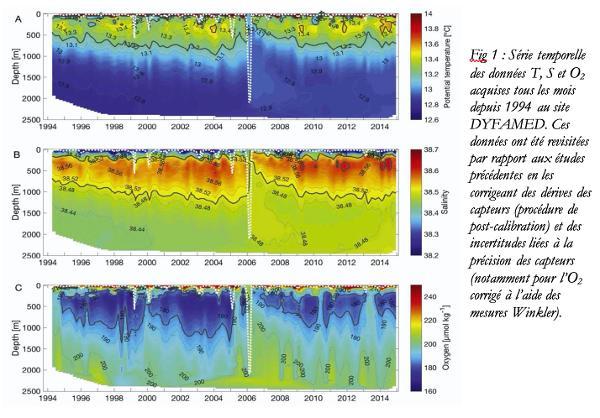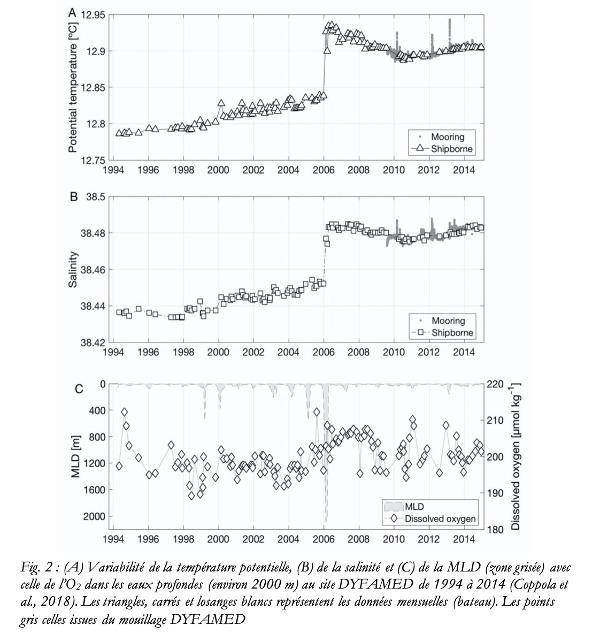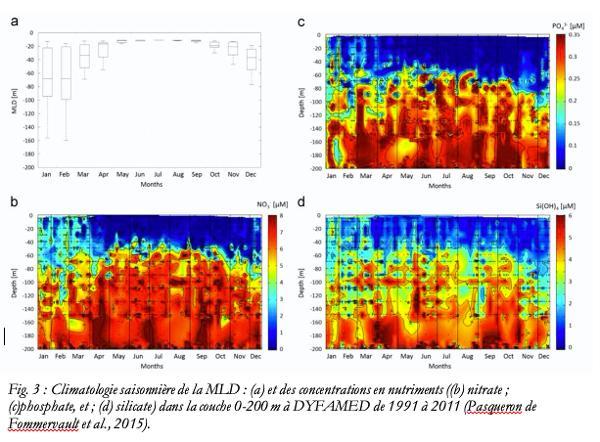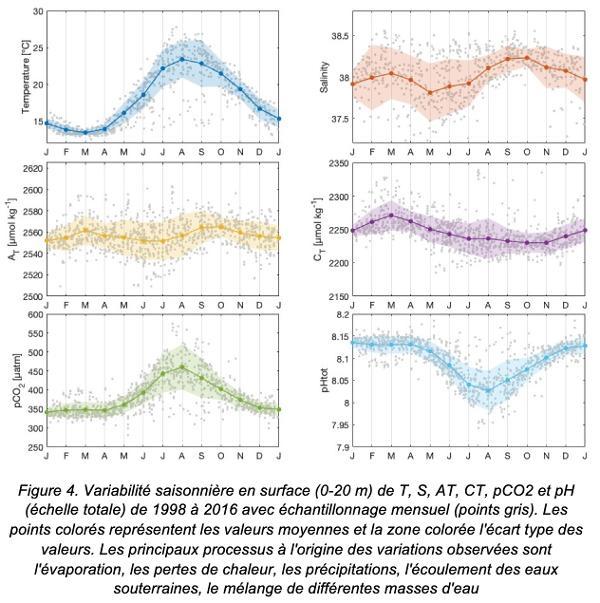We will only talk here about the latest major results of the DYFAMED series using the "water column" data acquired during the monthly missions.
In the Ligurian Sea, O2 measurements are used to trace both changes in the properties of water masses and surface organic production observed from 1994 to 2014 at the DYFAMED site (Fig. 1; Coppola et al., 2018). From the early 1990s to 2005, the oxygen minimum layer (OML) was observed between 200 and 1300 m, due to infrequent and low-intensity convective episodes in the Ligurian Sea (limiting O2 input from surface layers) and active bacterial remineralization in intermediate waters (responsible for O2 consumption and nutrient regeneration). Thus, at the DYFAMED site, an O2 decrease of 5 µmol/kg/year was observed at the OML level on average from 1994 to 2005 (Coppola et al., 2018). This would suggest the future appearance in the Ligurian Sea of a hypoxia zone (threshold of 60 µmol/kg) if no intense convection episode capable of fully ventilating the LIW took place within the next 25 years.

During the winter of 2005-2006, the convection process was particularly intense and rapid throughout the northwestern basin, including the Ligurian Sea (Zunino et al., 2012). Cold, dry winds and the accumulation of dense surface water since previous winters are the main cause of this convective event that mixed the entire water column in the Gulf of Lion and Ligurian Sea. This intense process made it possible to inject 24 mol O2 /m2 between 350 and 2000 m deep from December 2005 to March 2006, thus ventilating the OML in a consequent way. This anomaly has induced warming, stratification and ventilation of deep waters in the western basin (Schroeder et al., 2013). This change, called WMT, subsequently spread throughout the western Mediterranean basin leading to a gradual change in the deep waters of the western basin (Durrieu De Madron et al., 2013). Since this anomaly, the deep waters in the Ligurian Sea are mainly ventilated by the propagation of dense waters formed in the Gulf of Lion. Indeed, even if the Ligurian Sea is not a purely offshore convection zone as is the case in the Gulf of Lion, the most intense convection episodes generate changes that can easily be observed, particularly due to the dispersion of newly formed and therefore more oxygenated deep water masses flowing eastward towards the Ligurian Sea (Fig. 2). It is in particular thanks to the continuous measurements from the DYFAMED mooring and the measurements qualified in O2 that we were able to highlight this phenomenon (Coppola et al., 2018).

At the DYFAMED site, the results on the nutrient content made it possible to describe, with good accuracy, the characteristic seasonal cycle of the Ligurian region (thesis by O. Pasqueron de Formmervault, 2015). These nutrient concentrations are generally low at the surface, except in winter and early spring, when mixing processes are important (Fig. 3). Seasonal variations in the depth of the mixing layer (MLD) largely control this cycle, although a quantitative relationship cannot be established with the available temporal resolution (i.e., monthly). The results showed that a significant change in deepwater nutrient concentrations at DYFAMED occurred in 2005-2006, probably related to a deepwater uplift induced by the addition of new dense water. The study of molar abundance ratios also allows us to establish that phosphorus and nitrogen seem to play an equivalent role during productive periods. Over the period 1991-2011, and for the first time in the Mediterranean, results show ten-year trends in deep waters (Pasqueron de Fommervault et al., 2015). It has been observed that in intermediate and deep waters at DYFAMED, the Redfield ratio was 20:1 between 1991 and 2011 but this ratio increases by about 1.1% per year (Pasqueron de Fommervault et al., 2015). However, these Redfield reports are less significant in semi-enclosed seas, due in particular to the strong influence of external inputs, i.e. mainly atmospheric deposition.

The synthesis of AT-CT data on the carbonate system at the DYFAMED site now makes it possible to detect and understand long-term trends in AT, TC, pCO2 and pH in this region (Fig. 4). This synthesis was the subject of a chapter in a book on the Ligurian Sea, recently submitted to ISTE ("The Mediterranean Sea in the Era of Global Change - Evidence from 30 years of multidisciplinary study of the Ligurian Sea"). It is a unique database for validating biogeochemical simulations to better understand the future role of the Mediterranean Sea in CO2 absorption and acidification in the context of global change. Observations made since 1995 in the Ligurian Sea show a significant increase in pCO2 and a decrease in pH in 18 years. This is observed at the surface from direct measurements of pCO2 (Merlivat et al. 2018), as well as in the water column (AT, CT observations). However, the synthesis of these data also shows a significant inter-annual variability as observed in depth between 2004 and 2007. As with many biogeochemical variables, fixed-point measurements are not sufficient to fully understand their variability. In this context, autonomous sensors for pCO2, pH, oxygen and nutrients, not only at the surface but also in the water column (moorings, BGC-Argo floats), and included in the integrated observation system, should improve our vision of the ocean carbon variables that become mandatory to limit ocean acidification projections and the role of the Mediterranean Sea in the future of carbon pumps and marine ecosystems.

 , DIAMOND-RIQUIER Emilie
, DIAMOND-RIQUIER Emilie 





